Papers by Nicolene Lottering
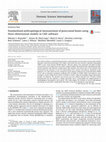
Forensic Science International, 2017
This study introduces a standardized protocol for conducting linear measurements of postcranial s... more This study introduces a standardized protocol for conducting linear measurements of postcranial skeletal elements using three-dimensional (3D) models constructed from post-mortem computed tomography (PMCT) scans. Using femoral DICOM datasets, reference planes were generated and plane-to-plane measurements were conducted on 3D surface rendered models. Bicondylar length, epicondylar breadth, anterior-posterior (AP) diameter, medial-lateral (ML) diameter and cortical area at the midshaft were measured by four observers to test the measurement error variance and observer agreement of the protocol (n = 6). Intra-observer error resulted in a mean relative technical error of measurement (%TEM) of 0.11 and an intraclass correlation coefficient (ICC) of 0.999 (CI = 0.998–1.000); inter-observer error resulted in a mean %TEM of 0.54 and ICC of 0.996 (CI = 0.979–1.000) for bicondylar length. Epicondylar breadth, AP diameter, ML diameter and cortical area also yielded minimal error. Precision testing demonstrated that the approach is highly repeatable and is recommended for implementation in anthropological investigation and research. This study exploits the benefits of virtual anthropology, introducing an innovative, standardized alternative to dry bone osteometric measurements.

Metopic synostosis is a craniofacial condition characterised by the premature fusion of the metop... more Metopic synostosis is a craniofacial condition characterised by the premature fusion of the metopic suture. This early fusion restricts frontal bone growth [17] and has significant impacts on the developing infant during a critical phase of rapid growth and development [4]. Diagnosis of the condition is usually achieved by clinical assessment, followed by a three-dimensional computed tomography (3D CT) scan, verifying premature metopic suture fusion. Purpose This retrospective study aims to investigate the timing of metopic suture fusion in the developing infant in an Australian subpopulation. Methods The study evaluates metopic suture fusion in 258 cranial 3D CT scans of children aged 0–24 months over a 5-year period (2011–2016), scanned at Women’s and Children’s Hospital. Results The findings suggest that the age range over which physiologic metopic suture fusion occurs is larger than previously reported. Conclusions The approximate range for physiologic fusion was found to be 3–19 months and patients with fusion within this range can be considered normal. Complete suture fusion is expected by 19 months. Additionally, results indicate suture fusion prior to 3 months is abnormal and diagnostically indicative of metopic synostosis.
Author response to: Brough et al. in response to the recently published article: Lottering, N., MacGregor, D.M., Barry, M.D., Reynolds, M.S., Gregory, L.S., 2014. Introducing standardized protocols for anthropological measurement of virtual sub-adult crania using computed tomography 2(1), 34–38 Journal of Forensic Radiology and Imaging, 2014
Gregory, L.S., 2014. Introducing standardized protocols for anthropological measurement of virtua... more Gregory, L.S., 2014. Introducing standardized protocols for anthropological measurement of virtual sub-adult crania using computed tomography 2(1), 34-38
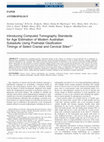
Contemporary, population-specific ossification timings of the cranium are lacking in current lite... more Contemporary, population-specific ossification timings of the cranium are lacking in current literature due to challenges in obtaining large repositories of documented subadult material, forcing Australian practitioners to rely on North American, arguably antiquated reference standards for age estimation. This study assessed the temporal pattern of ossification of the cranium and provides recalibrated probabilistic information for age estimation of modern Australian children. Fusion status of the occipital and frontal bones, atlas, and axis was scored using a modified two- to four-tier system from cranial/cervical DICOM datasets of 585 children aged birth to 10 years. Transition analysis was applied to elucidate maximum-likelihood estimates between consecutive fusion stages, in conjunction with Bayesian statistics to calculate credible intervals for age estimation. Results demonstrate significant sex differences in skeletal maturation (p < 0.05) and earlier timings in comparison with major literary sources, underscoring the requisite of updated standards for age estimation of modern individuals.
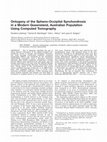
Due to disparity regarding the age at which skeletal maturation of the spheno-occipital synchondr... more Due to disparity regarding the age at which skeletal maturation of the spheno-occipital synchondrosis occurs in forensic and biological literature, this study provides recalibrated multi-slice computed tomography (MSCT) age standards for the Australian (Queensland) population, using a Bayesian statistical approach. The sample comprises retrospective cranial/cervical MSCT scans obtained from 448 males and 416 females aged birth to 20 years from the Skeletal Biology and Forensic Anthropology Research Osteological Database. Fusion status of the synchondrosis was scored using a modified six-stage scoring tier on an MSCT platform, with negligible observer error (κ = 0.911 ± 0.04, ICC = 0.994). Bayesian transition analysis indicates that females are most likely to transition to complete fusion at 13.1 years and males at 15.6 years. Posterior densities were derived for each morphological stage, with complete fusion of the synchondrosis attained in all Queensland males over 16.3 years of age and females aged 13.8 years and older. The results demonstrate significant sexual dimorphism in synchondrosis fusion and are suggestive of intra-population variation between major geographic regions in Australia. This study contributes to the growing repository of contemporary anthropological standards calibrated for the Queensland milieu to improve the efficacy of the coronial process for medico-legal death investigation. As a stand-alone age indicator, the basicranial synchondrosis may be consulted as an exclusion criterion when determining the age of majority that constitutes 17 years in Queensland forensic practice.

Objectives: This study introduces and assesses the precision of a standardized protocol for anthr... more Objectives: This study introduces and assesses the precision of a standardized protocol for anthropometric measurement of the juvenile cranium using three-dimensional surface rendered models, for implementation in forensic investigation or paleodemographic research.
Materials and Methods: A subset of multi-slice computed tomography (MSCT) DICOM datasets (n=10) of modern Australian subadults (birth – 10 years) was accessed from the “Skeletal Biology and Forensic Anthropology Virtual Osteological Database” (n>1200), obtained from retrospective clinical scans taken at Brisbane children hospitals (2009 – 2013). The capabilities of Geomagic Design XTM form the basis of this study; introducing standardized protocols using triangle surface mesh models to (i) ascertain linear dimensions using reference plane networks and (ii) calculate the area of complex regions of interest on the cranium.
Results: The protocols described in this paper demonstrate high levels of repeatability between five observers of varying anatomical expertise and software experience. Intra- and inter-observer error was indiscernible with total technical error of measurement (TEM) values ≤ 0.56mm, constituting < 0.33% relative error (rTEM) for linear measurements; and a TEM value of ≤ 12.89mm2, equating to < 1.18% (rTEM) of the total area of the anterior fontanelle and contiguous sutures.
Conclusions: Exploiting the advances of MSCT in routine clinical assessment, this paper assesses the application of this virtual approach to acquire highly reproducible morphometric data in a non-invasive manner for human identification and population studies in growth and development. The protocols and precision testing presented are imperative for the advancement of “virtual anthropology” into routine Australian medico-legal death investigation.
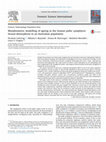
Forensic Science International , Jan 10, 2014
Despite the prominent use of the pubic symphysis for age estimation in forensic anthropology, lit... more Despite the prominent use of the pubic symphysis for age estimation in forensic anthropology, little has been documented regarding the quantitative morphological and micro-architectural changes of this surface. Specifically, utilising post-mortem computed tomography data from a large, contemporary Australian adult population, this study aimed to evaluate sexual dimorphism in the morphology and bone composition of the symphyseal surface; and temporal characterisation of the pubic symphysis in individuals of advancing age.
The sample consisted of multi-slice computed tomography (MSCT) scans of the pubic symphysis (slice thickness: 0.5 mm, overlap: 0.1 mm) of 200 individuals of Caucasian ancestry aged 15–70 years, obtained in 2011. Surface rendering reconstruction of the symphyseal surface was conducted in OsiriX1 (v.4.1) and quantitative analyses in Rapidform XOS and OsteomeasureTM. Morphometric variables including inter-pubic distance, surface area, circumference, maximum height and width of the symphyseal surface and micro-architectural assessment of cortical and trabecular bone compositions were quantified using novel automated engineering software capabilities.
The major results of this study are correlated with the macroscopic ossification and degeneration pattern of the symphyseal surface, demonstrating significant age-related changes in the morphometric and bone tissue variables between 15 and 70 years. Regardless of sex, the overall dimensions of the symphyseal surface increased with age, coupled with a decrease in bone mass in the trabecular and cortical bone compartments. Significant differences between the ventral, dorsal and medial cortical surfaces were observed, which may be correlated to bone formation activity dependent on muscle activity and ligamentous attachments. Our study demonstrates significant sexual dimorphism at this site, with males exhibiting greater surface dimensions than females. These baseline results provide a detailed insight into the changes in the structure of the pubic symphysis with ageing and sexually dimorphic features associated with the cortical and trabecular bone profiles.
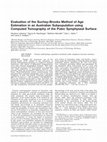
Am J Phys Anthropol, Jan 3, 2013
Despite the prominent use of the Suchey–Brooks (S–B) method of age estimation in forensic anthrop... more Despite the prominent use of the Suchey–Brooks (S–B) method of age estimation in forensic anthropological practice, it is subject to intrinsic limitations, with reports of differential interpopulation error rates between geographical locations. This study assessed the accuracy of the S–B method to a contemporary adult population in Queensland, Australia and provides robust age parameters calibrated for our population. Three-dimensional surface reconstructions were generated from computed tomography scans of the pubic symphysis of male and female Caucasian individuals aged 15–70 years (n =195) in Amira and Rapidform. Error was analyzed on the basis of bias, inaccuracy and percentage correct classification for left and right symphyseal surfaces. Application of transition analysis and Chi-square statistics demonstrated 63.9 and 69.7% correct age classification associated with the left symphyseal surface of Australian males and females, respectively, using the S–B method. Using Bayesian statistics, probability density distributions for each S–B phase were calculated, providing refined age parameters for our population. Mean inaccuracies of 6.77 (62.76) and 8.28 (64.41) years were reported for the left surfaces of males and females, respectively; with positive biases for younger individuals (<55 years) and negative biases in older individuals. Significant sexual dimorphism in the application of the S–B method was observed; and asymmetry in phase classification of the pubic symphysis was a frequent phenomenon. These results recommend that the S–B method should be applied with caution in medico-legal death investigations of Queensland skeletal remains and warrant further investigation of reliable age estimation techniques.
Gregory, L.S., 2014. Introducing standardized protocols for anthropological measurement of virtua... more Gregory, L.S., 2014. Introducing standardized protocols for anthropological measurement of virtual sub-adult crania using computed tomography 2(1), 34-38
Presentations/Published Abstracts by Nicolene Lottering
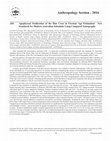
After attending this presentation, attendees will: (1) appreciate recalibrated population-specifi... more After attending this presentation, attendees will: (1) appreciate recalibrated population-specific age standards for Australian subadults based on the Risser Sign, and the implication of idiopathic scoliosis on the derivation of age estimates; and, (2) become familiar with ontogeny of the iliac crest apophysis using 3D reconstructions of Multi-Slice Computed Tomography (MSCT) data. This presentation will impact the forensic science community by demonstrating the potential of a contemporary MSCT database of abdomino-pelvic scans to assess the currency of methods such as the Risser Sign for clinical age assessment of maturation milestones. 1 This presentation discusses and surmounts limitations associated with conventional radiographs by utilizing MSCT Multi-Planar Reformatted (MPR) and Volume Rendered Reconstructions (VRR) to formulate Australian standards for forensic age estimation, based on excursion and fusion of the iliac crest apophysis. Accurate age-at-death estimation of skeletal remains represents a key element in forensic anthropology, while age estimates of living individuals are of increasing importance for forensic medicine, considering the increase in transnational migratory movements. The age of criminal responsibility under Australian federal law is ten years of age, while doli incapax, the maximum age of presumption against criminal responsibility constitutes 14 years of age. Wittschieber et al. contend that the Risser Sign is suitable for forensic age estimation, especially the demarcation of the 14th year of life. 2 Combined with other roentgenographic indices of maturation, excursion of the iliac crest is used to estimate remaining growth potential and the likelihood of progression in patients with adolescent idiopathic scoliosis, which influences clinical intervention decisions such as bracing or surgery. The present study seeks to determine whether the Risser Sign, used routinely for assessing iliac crest maturity in scoliosis patients, is suitable for age estimation of subadults, particularly in cases claiming doli incapax. The sample composes MSCT abdomino-pelvic Digital Imaging and Communications in Medicine (DICOM) data (0.5mm/0.3mm) acquired from 255 'trauma-screened' Australian individuals aged 6-25 years, admitted to Brisbane children's hospitals between 2007 and 2014. The Risser US six-stage system was employed to score ossification of the iliac crest. Transition analysis was applied to elucidate maximum likelihood estimates between maturational states; robust age parameters were established using a Bayesian statistical approach, with an MCMC sampler. Volume averaging reconstructions of DICOM datasets, using a coronal reformat were employed to create pseudoradiographs for Risser scoring of trauma-screened children. Standards for Queensland idiopathic scoliosis patients (females: 436, males: 95) aged 6 years to 23 years were derived from clinical databases comprising conventional surveillance radiographs, including the pelvis and analytic data (e.g., Risser Sign, Cobb Angle) from a scoliosis progression study performed by the Paediatric Spine Research Group between 1995 and 2007. Comparisons of maximum likelihood estimates demonstrate no significant developmental anomalies in iliac crest maturation associated with idiopathic scoliosis. Age-at-transition for apophyseal appearance corresponds to 12.99±1.3 years in females and 13.87±0.94 years in males. Posterior distributions signify complete appositional growth (Risser 4) at 15.06 (95% CI:13.5-16.7) years and 15.99 (95% CI:14.9-17.0) years in females and males, respectively, an important demarcation stage for scoliosis management. Lack of discriminant power between stages 2-4 demonstrate that the 14th-year legal demarcation cannot reliably be determined in females using this method on conventional radiographs.
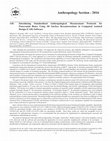
After attending this presentation, attendees will appreciate the improved accuracy and reliabilit... more After attending this presentation, attendees will appreciate the improved accuracy and reliability attributed to semi-automated anthropological measurement protocols on 3D reconstructions of postcranial bones using CAD software. This presentation will impact the forensic science community by demonstrating the benefits of Multi-Slice Computed Tomography (MSCT) and the advances of a virtual approach as a non-invasive method for obtaining reproducible morphometric information in anthropological investigation. The visualization and measurement capabilities of reverse engineering software will be discussed. The protocol introduced in this study and the precision testing results presented are essential for advancing current medicolegal death investigations, accentuating the advantages of " virtual anthropology. " Consistent with the International Criminal Police Organization (INTERPOL) Disaster Victim Identification Guide, postmortem identification during mass disasters systematically involves the utilization of MSCT. Specifically in Australia, postmortem MSCT was regarded as a valuable tool in disaster victim identification during the 2009 Victorian Bushfires and constitutes standard protocol for external autopsy in a number of Australian mortuaries. The 3D surface-rendered models in CAD software has the potential to increase measurement accuracy in comparison to Multi-Planar Reformatted (MPR) assessment, which uses contiguous 2D orthoslices, where the outer boundary of macroscopic bony landmarks may be arduous to determine. Utility of MPR models also requires a considerable level of anatomical imaging knowledge, as the investigator is required to mentally construct a 3D representation from 2D images. The goal of this present study was to introduce a contemporary osteometric protocol using CAD software and to conduct observer error testing to assess the reliability of this protocol. Six thin-slice Digital Imaging and Communications in Medicine (DICOM) datasets (thickness: 2mm, overlap: 1.6mm, voxel size: 0.78mm x 0.78mm x 2.0mm) of the femoral region of contemporary adult Australian individuals (aged neonate to 75 years old) were accessed from the Skeletal Biology and Forensic Anthropology Virtual Osteological Database. The femora were subject to manual segmentation to produce an isosurface model compatible with the engineering software program Geomagic Design X ™ for osteometric examination. In Geomagic Design X ™ , the principal component axes were realigned for the construction of a series of anatomical reference planes required to depict a " virtual osteometric board. " With reference to silhouette curves, extreme position planes corresponding to the outermost boundary of the isosurface are identified in order to obtain automated plane-to-plane measurements. Bicondylar length and epicondylar breadth were measured by four observers differing in CAD software experience over three separate days to evaluate intra-and inter-observer error. Technical Error of Measurement (TEM), relative Technical Error of Measurement (%TEM), and Intraclass Correlation Coefficient (ICC) were calculated to quantify the measurement error variance and observer agreement of the protocol. Intra-and inter-observer error results demonstrate that the linear measurement protocol introduced is highly repeatable. Specifically, intra-observer error resulted in %TEM=0.10, ICC=1.000 (CI=0.999-1.000) for bicondylar length, %TEM=0.19, ICC=0.995 (CI=0.980-0.999) for epicondylar breadth. Inter-observer error resulted in %TEM=0.50, ICC=0.995 (CI=0.978-0.999) for bicondylar length, %TEM=0.20, and ICC=0.996 (CI=0.979-1.000) for epicondylar breadth. Since these results are within the acceptable levels of agreements for anthropometric measures, it is recommended that this protocol be implemented in anthropological casework and contemporary anthropological research. The protocol introduced in this study utilizes high-quality 3D models, which allow " hidden features " such as the medullary cavities to be observed, with the software also providing the opportunity for novel geometric morphometric methods to be developed. A further benefit of CAD software is the use of automated plane-to-plane measurements, which eliminates the requirement of manual identification of landmarks, also reducing the subjectivity associated with the alignment of the bone in MPR protocols.
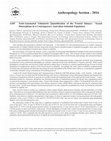
After attending this presentation, attendees will appreciate: (1) the benefits of a semi-automate... more After attending this presentation, attendees will appreciate: (1) the benefits of a semi-automated protocol to conduct volumetric measurements of complex skeletal elements using tissue density-based voxel-processing of computed tomography scans; and, (2) the presence of sexual dimorphism in frontal sinus volume in subadults. This presentation will impact the forensic science community by advancing understanding of subadult frontal sinus development through the use of 3D reconstructed Multi-Slice Computed Tomography (MSCT) scans. This research will also reinforce the invaluable nature and varied applicability a contemporary virtual skeletal repository offers to both forensic anthropology and osteoarchaeological fields of research. Due to high probability in the recovery of the frontal bones within fragmented remains, comparison of frontal sinus morphology in antemortem versus postmortem radiographs are routinely conducted for personal identification in forensic casework. While sexual dimorphism in frontal sinus size has been widely reported in adults, there is currently no research signifying the age of onset of sexual dimorphism in morphometric analyses of the frontal sinuses in subadults. Accordingly, this study seeks to establish a temporal profile of frontal sinus development and determine the timing of sexual dimorphism of the frontal sinus volume in a contemporary population of Australian subadults, using a standardized 3D modeling protocol. A total of 89 cranial Digital Imaging and Communications in Medicine (DICOM) datasets (males: n=45, females: n=44) aged 6 years to 19 years were accessed from the Skeletal Biology and Forensic Anthropology Virtual Osteological Database and imported into an advanced visualization software to generate an isosurface model and segmented masks of the right and left frontal sinuses. 1 A semi-automated method for volumetric calculation was developed to produce a standardized protocol for frontal sinus segmentation based on material discriminatory voxel intensity values. Voxels with intensity values ranging from-1,000 to 150 Hounsfield Units (HU) were selected, corresponding to the tissue density of air, fibrous connective tissue, cellular debris, and mucous that may be contained within the sinus cavity. Frontal chord (Bregma-Nasion) measurements were also conducted to standardize the crania, accounting for individual variability in cephalic size. Intra-and inter-observer testing was conducted on three sample datasets obtained from randomly selected individuals of varying ages. Intra-observer error demonstrated high precision and consistency between repeated measurements with a mean percent Technical Error of Measurement (%TEM) of 3.15% and Intra-Class Correlation Coefficient (ICC) of 1.00 (Confidence Interval (CI)=0.992-1.00). Similarly, inter-observer reliability demonstrated a high degree of observer agreement despite varying anatomical and radiographic experience, with a mean %TEM of 1.26% and ICC of 0.99 (CI=0.991-1.00). Age and sex effects were analyzed using independent Student t-tests with relevant post-hoc tests.
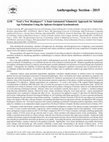
After attending this presentation, attendees will appreciate the advantages and principal process... more After attending this presentation, attendees will appreciate the advantages and principal processes of applying a semi-automated growth plate measurement protocol based on voxelization and volume calculation to quantify the tissue composition of irregular skeletal regions such as the spheno-occipital synchondrosis.
This presentation will impact the forensic science community by exploiting the utility of material density distributions embedded in cross-sectional tomography data to advance methodological and computer-assisted techniques; providing an attractive alternative to the modal, phase-based design common among subadult age estimation.
Due to the high probability of recovering the skull in anthropological casework, the spheno-occipital synchondrosis is frequently used as an indicator of subadult age, as it constitutes the last site in the cranium to terminate growth. Disparity regarding the reported age of complete synchondrosis fusion is evident in current literature, possibly attributed to inconsistencies in research design and visualization medium. Consequently the reliability of ordered age-phase strategies employed in qualitative assessment may be questioned due to (i) ambiguity in phase descriptions, (ii) variation in the number of stages and (iii) significant overlap in age ranges between consecutive phases.
Volumetric analysis using automated segmentation algorithms constitutes standard practice in medical science; for monitoring skeletal toxicity and neurological assessment of intracranial pathologies, where voxelization and volume calculation are imperative for diagnostic and treatment decisions. A semi-automated method for volumetric measurement was developed based on differential voxel intensity values of the Hounsfield scale (HU) that discriminate material composition of the spheno-occipital synchondrosis in computed tomography (CT) orthoslices. Manual segmentation was conducted to (i) create a sub-volume of the original DICOM stack, and (ii) isolate the joint space to create a binary tissue classification mask. MATLAB® commands were written to eliminate voxels exceeding the mask, and produce a histogram of intensity values for each individual based on voxel-clustering of biological material. Intensity values were correlated to specific tissue types i.e. hyaline vs. calcified cartilage, using Bayesian probabilistic analysis; followed by tissue volume calculations using the voxel count and size. Linear synchondrosal measurements were conducted to eliminate the effect of size. The protocol was applied to cranial CT data from The Skeletal Biology and Forensic Anthropology Research Osteological Database on 169 Australian individuals aged birth to 18 years to generate preliminary density histograms for age estimation using mixture modeling. Non-linear regression with variance modeling was utilized to formulate predictive algorithms, which will be subject to validation on an independent sample acquired from The Royal Children’s Hospital, Brisbane and disclosed in February 2015.
Preliminary results demonstrate a gradual decline in standardized cartilaginous volume of the spheno-occipital synchondrosis until 16.3 and 13.8 years in males and females, which constitutes the age of complete fusion in our population. During infancy, the mean volume in males was 461.67±49.28mm3 compared to 299.35±32.76mm3 in females; with males exhibiting significantly greater volumes (P<0.05) across all age intervals until 14 years, which correlates with delayed closure of the synchondrosis. Males exhibit a consistent linear decline in volume with age, while the rate of decline accelerates after 8 years in females. Height and width variables demonstrate expansion through adolescence; the most prominent increase observed between birth and four years during which time chondrocyte proliferation and matrix production occur rapidly. Proceeding this period, endochondral ossification commences at the superolateral borders, causing a reduction in the gradient of growth. Significantly, voxel cluster distributions successfully discriminate tissue changes with increasing age, with neonates exhibiting a cluster peak corresponding to the density of fibrous tissue. At five years the highest proportion of intensity values denote hyaline cartilage in contrast to cluster peaks at 150-250HU at 14 years of age, emphasizing significant cartilage calcification prior to complete ossification (+250HU) at 16 years in Queensland males. New mathematical models, validated on a large, modern Australian population will be introduced as a tool for methodological refinement, providing a robust alternative or adjunct to current subadult aging methods. The utility of the proposed methodological approach to epiphyseal growth plates of the post-cranial skeleton e.g. medial clavicle and iliac crest for multi-factorial age estimation will also be discussed.

After attending this presentation, attendees will gain awareness of the ontogeny of cranial matu... more After attending this presentation, attendees will gain awareness of the ontogeny of cranial maturation, specifically: (1) the fusion timings of primary ossification centers in the basicranium; and (2) the temporal pattern of closure of the anterior fontanelle, to develop new population-specific age standards for medicolegal death investigation of Australian subadults.
This presentation will impact the forensic science community by demonstrating the potential of a contemporary forensic subadult Computed Tomography (CT) database of cranial scans and population data, to recalibrate existing standards for age estimation and quantify growth and development of Australian children. This research welcomes a study design applicable to all countries faced with paucity in skeletal repositories.
Accurate assessment of age-at-death of skeletal remains represents a key element in forensic anthropology methodology. In Australian casework, age standards derived from American reference samples are applied in light of scarcity in documented Australian skeletal collections. Currently practitioners rely on antiquated standards, such as the Scheuer and Black1 compilation for age estimation, despite implications of secular trends and population variation. Skeletal maturation standards are population specific and should not be extrapolated from one population to another, while secular changes in skeletal dimensions and accelerated maturation underscore the importance of establishing modern standards to estimate age in modern subadults. Despite CT imaging becoming the gold standard for skeletal analysis in Australia, practitioners caution the application of forensic age standards derived from macroscopic inspection to a CT medium, suggesting a need for revised methodologies.
Multi-slice CT scans of subadult crania and cervical vertebrae 1 and 2 were acquired from 350 Australian individuals (males: n=193, females: n=157) aged birth to 12 years. The CT database, projected at 920 individuals upon completion (January 2014), comprises thin-slice DICOM data (resolution: 0.5/0.3mm) of patients scanned since 2010 at major Brisbane Childrens Hospitals. DICOM datasets were subject to manual segmentation, followed by the construction of multi-planar and volume rendering cranial models, for subsequent scoring. The union of primary ossification centers of the occipital bone were scored as open, partially closed or completely closed; while the fontanelles, and vertebrae were scored in accordance with two stages. Transition analysis was applied to elucidate age at transition between union states for each center, and robust age parameters established using Bayesian statistics. In comparison to reported literature, closure of the fontanelles and contiguous sutures in Australian infants occur earlier than reported, with the anterior fontanelle transitioning from open to closed at 16.7±1.1 months. The metopic suture is closed prior to 10 weeks post-partum and completely obliterated by 6 months of age, independent of sex. Utilizing reverse engineering capabilities, an alternate method for infant age estimation based on quantification of fontanelle area and non-linear regression with variance component modeling will be presented. Closure models indicate that the greatest rate of change in anterior fontanelle area occurs prior to 5 months of age.
This study complements the work of Scheuer and Black1, providing more specific age intervals for union and temporal maturity of each primary ossification center of the occipital bone. For example, dominant fusion of the sutura intra-occipitalis posterior occurs before 9 months of age, followed by persistence of a hyaline cartilage tongue posterior to the foramen magnum until 2.5 years; with obliteration at 2.9±0.1 years. Recalibrated age parameters for the atlas and axis are presented, with the anterior arch of the atlas appearing at 2.9 months in females and 6.3 months in males; while dentoneural, dentocentral and neurocentral junctions of the axis transitioned from non-union to union at 2.1±0.1 years in females and 3.7±0.1 years in males. These results are an exemplar of significant sexual dimorphism in maturation (p<0.05), with girls exhibiting union earlier than boys, justifying the need for segregated sex standards for age estimation.
Studies such as this are imperative for providing updated standards for Australian forensic and pediatric practice and provide an insight into skeletal development of this population. During this presentation, the utility of novel regression models for age estimation of infants will be discussed, with emphasis on three-dimensional modeling capabilities of complex structures such as fontanelles, for the development of new age estimation methods.

After attending this presentation, attendees will gain awareness of: (1) the error and uncertaint... more After attending this presentation, attendees will gain awareness of: (1) the error and uncertainty associated with the application of the Suchey-Brooks (S-B) method of age estimation of the pubic symphysis to a contemporary Australian population; (2) the implications of sexual dimorphism and bilateral asymmetry of the pubic symphysis through preliminary geometric morphometric assessment; and (3) the value of three-dimensional (3D) autopsy data acquisition for creating forensic anthropological standards.
This presentation will impact the forensic science community by demonstrating that, in the absence of demographically sound skeletal collections, post-mortem autopsy data provides an exciting platform for the construction of large contemporary ‘virtual osteological libraries’ for which forensic anthropological research can be conducted on Australian individuals. More specifically, this study assesses the applicability and accuracy of the S-B method to a contemporary adult population in Queensland, Australia, and using a geometric morphometric approach, provides an insight to the age-related degeneration of the pubic symphysis.
Despite the prominent use of the Suchey-Brooks (1990) method of age estimation in forensic anthropological practice, it is subject to intrinsic limitations, with reports of differential inter-population error rates between geographical locations1-4. Australian forensic anthropology is constrained by a paucity of population specific standards due to a lack of repositories of documented skeletons. Consequently, in Australian casework proceedings, standards constructed from predominately American reference samples are applied to establish a biological profile. In the global era of terrorism and natural disasters, more specific population standards are required to improve the efficiency of medico-legal death investigation in Queensland.
The sample comprises multi-slice computed tomography (MSCT) scans of the pubic symphysis (slice thickness: 0.5mm, overlap: 0.1mm) on 195 individuals of caucasian ethnicity aged 15-70 years. Volume rendering reconstruction of the symphyseal surface was conducted in Amira® (v.4.1) and quantitative analyses in Rapidform® XOS. The sample was divided into ten-year age sub-sets (eg. 15-24) with a final sub-set of 65-70 years. Error with respect to the method’s assigned means were analysed on the basis of bias (directionality of error), inaccuracy (magnitude of error) and percentage correct classification of left and right symphyseal surfaces. Morphometric variables including surface area, circumference, maximum height and width of the symphyseal surface and micro-architectural assessment of cortical and trabecular bone composition were quantified using novel automated engineering software capabilities.
The results of this study demonstrated correct age classification utilizing the mean and standard deviations of each phase of the S-B method of 80.02% and 86.18% in Australian males and females, respectively. Application of the S-B method resulted in positive biases and mean inaccuracies of 7.24 (±6.56) years for individuals less than 55 years of age, compared to negative biases and mean inaccuracies of 5.89 (±3.90) years for individuals greater than 55 years of age. Statistically significant differences between chronological and S-B mean age were demonstrated in 83.33% and 50% of the six age subsets in males and females, respectively. Asymmetry of the pubic symphysis was a frequent phenomenon with 53.33% of the Queensland population exhibiting statistically significant (χ2 - p<0.01) differential phase classification of left and right surfaces of the same individual. Directionality was found in bilateral asymmetry, with the right symphyseal faces being slightly older on average and providing more accurate estimates using the S-B method5. Morphometric analysis verified these findings, with the left surface exhibiting significantly greater circumference and surface area than the right (p<0.05). Morphometric analysis demonstrated an increase in maximum height and width of the surface with age, with most significant changes (p<0.05) occurring between the 25-34 and 55-64 year age subsets. These differences may be attributed to hormonal components linked to menopause in females and a reduction in testosterone in males. Micro-architectural analysis demonstrated degradation of cortical composition with age, with differential bone resorption between the medial, ventral and dorsal surfaces of the pubic symphysis.
This study recommends that the S-B method be applied with caution in medico-legal death investigations of unknown skeletal remains in Queensland. Age estimation will always be accompanied by error; therefore this study demonstrates the potential for quantitative morphometric modelling of age related changes of the pubic symphysis as a tool for methodological refinement, providing a rigor and robust assessment to remove the subjectivity associated with current pelvic aging methods.

Establishing age-at-death for skeletal remains is a vital component of forensic anthropology. The... more Establishing age-at-death for skeletal remains is a vital component of forensic anthropology. The Suchey-Brooks (S-B) method of age estimation has been widely utilised since 1986 and relies on a visual assessment of the pubic symphyseal surface in comparison to a series of casts. Inter-population studies (Kimmerle et al., 2005; Djuric et al., 2007; Sakaue, 2006) demonstrate limitations of the S-B method, however, no assessment of this technique specific to Australian populations has been published.
Aim: This investigation assessed the accuracy and applicability of the S-B method to an adult Australian Caucasian population by highlighting error rates associated with this technique.
Methods: Computed tomography (CT) and contact scans of the S-B casts were performed; each geometrically modelled surface was extracted and quantified for reference purposes. A Queensland skeletal database for Caucasian remains aged 15 – 70 years was initiated at the Queensland Health Forensic and Scientific Services – Forensic Pathology Mortuary (n=350). Three-dimensional reconstruction of the bone surface using innovative volume visualisation protocols in Amira® and Rapidform® platforms was performed. Samples were allocated into 11 sub-sets of 5-year age intervals and changes associated with the surface geometry were quantified in relation to age, gender and asymmetry.
Results: Preliminary results indicate that computational analysis was successfully applied to model morphological surface changes. Significant differences in observed versus actual ages were noted. Furthermore, initial morphological assessment demonstrates significant bilateral asymmetry of the pubic symphysis, which is unaccounted for in the S-B method. These results propose refinements to the S-B method, when applied to Australian casework.
Conclusion: This investigation promises to transform anthropological analysis to be more quantitative and less invasive using CT imaging. The overarching goal contributes to improving skeletal identification and medico-legal death investigation in the coronial process by narrowing the range of age-at-death estimation in a biological profile.
Conference Presentations by Nicolene Lottering
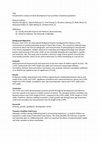
Background/Objectives: Between 1964-1974, the International Biological Program investigated the i... more Background/Objectives: Between 1964-1974, the International Biological Program investigated the influence of the environment on isolated population groups in Papua New Guinea. This researched collected large amounts of data in the form of radiographs, and measurements of anthropological characteristics from various populations. Modern advances in computing and imaging technology have allowed precise measurements of this data, which can be correlated alongside each population’s specific, and restrictive, diet. This study aims to provide a reference range of bone growth characteristics from healthy juveniles, which can be used to determine if a child is developing at a normal rate. Methods: Anthropometrical measurements and hand-wrist X-rays were taken of children aged 8-16 years. The 2-MTC (metacarpal) and 3-MTC length and width were measured using ImageJ software. Correlations between bone parameters and stature were analysed. Pearson's correlation coefficient, or an ANOVA was applied to test for significance (P<0.05). Results: Preliminary studies using females from all three regions found a relationship between stature and length of the 2-MTC and 3-MTC. Significant correlations were observed between stature and 2-MTC length and 3-MTC length. Correlations were also found between stature and 2-MTC width and 3-MTC width. Conclusion: The 2-MTC and 3-MTC demonstrated consistent growth throughout development and therefore have the capacity to be used as a reliable measure of stature. The strongest positive correlation was between stature and 2-MTC length (P<0.01), compared to the 2-MTC width, 3-MTC length or 3-MTC width. Therefore, clinicians seeking to examine a child's growth rate through bone age assessment could most accurately use measurements from the length of the 2-MTC.

Problem Statement: Based on 2016 Student Evaluation data, students found the threshold learning c... more Problem Statement: Based on 2016 Student Evaluation data, students found the threshold learning concept associated with anatomy difficult to master, as content can be overwhelming due to the perceived need to memorise a large volume of material. Student feedback suggested increased anxiety, potentially resulting in academic underperformance and/or high attrition rates during the first weeks of semester. Since 94% of the second year, Musculoskeletal Anatomy cohort were aged 24 years or younger, unique barriers of teaching digital learners included the need for instant gratification and immediate rewards.
Initiative Purpose: Consistent with Dunne and Zandstra’s (2011) model for students-as-change agents, I developed the ‘Peer2Peer Alliance in Anatomy’ Program, in which the most substantial contribution was co-creation to promote a learning community, through embedding peer-teaching into the curriculum and facilitating active learning through co-design of revision content by 3rd year high achieving students. The peer leaders transformed the digital strategy, under a Teaching with Technology Framework, to create an inclusive student experience, based on learning preferences and social media integration to change interaction patterns between learners and teachers.
Methodology: Deployment of VARK demonstrated that 63% of students were kinaesthetic/visual learners; inspiring the design of visual experiences in blended classrooms. Youtube (84%) was the preferred online content interface, followed by Echo360 (83%) and quizzes (74%). Such data informed the utility of social media for the pastoral care component of the modified Flipped Classroom model, co-created pre-class videos, post-class quizzes and revision podcast, and modern media streams. Specifically, the lightboard has been embraced by co-creation quality enhancement projects across Medicine and Dentistry Disciplines.
Contributions: The program’s success was attested to by improvement in overall student satisfaction in course facilitation and improvement in academic performance. Fail rates decreased from 36% in 2015 to 14% in 2018. 93% of students reported an increased sense of community evidenced by “I really loved having the peer leaders in this course. It was great being able to ask them questions and gain useful advice from them, since they’ve already done it before” (Focus Group, 2017); while student engagement improved, with 73% attending lectures. The retrospective design of the Students as Partners model saw students develop leadership qualities, resulting in empowerment, inclusivity, and improved communication skills to prepare them for STEM related careers




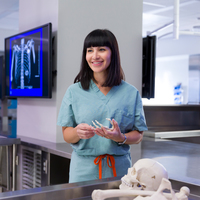
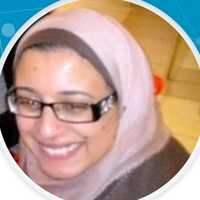


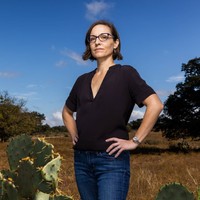

Uploads
Papers by Nicolene Lottering
Materials and Methods: A subset of multi-slice computed tomography (MSCT) DICOM datasets (n=10) of modern Australian subadults (birth – 10 years) was accessed from the “Skeletal Biology and Forensic Anthropology Virtual Osteological Database” (n>1200), obtained from retrospective clinical scans taken at Brisbane children hospitals (2009 – 2013). The capabilities of Geomagic Design XTM form the basis of this study; introducing standardized protocols using triangle surface mesh models to (i) ascertain linear dimensions using reference plane networks and (ii) calculate the area of complex regions of interest on the cranium.
Results: The protocols described in this paper demonstrate high levels of repeatability between five observers of varying anatomical expertise and software experience. Intra- and inter-observer error was indiscernible with total technical error of measurement (TEM) values ≤ 0.56mm, constituting < 0.33% relative error (rTEM) for linear measurements; and a TEM value of ≤ 12.89mm2, equating to < 1.18% (rTEM) of the total area of the anterior fontanelle and contiguous sutures.
Conclusions: Exploiting the advances of MSCT in routine clinical assessment, this paper assesses the application of this virtual approach to acquire highly reproducible morphometric data in a non-invasive manner for human identification and population studies in growth and development. The protocols and precision testing presented are imperative for the advancement of “virtual anthropology” into routine Australian medico-legal death investigation.
The sample consisted of multi-slice computed tomography (MSCT) scans of the pubic symphysis (slice thickness: 0.5 mm, overlap: 0.1 mm) of 200 individuals of Caucasian ancestry aged 15–70 years, obtained in 2011. Surface rendering reconstruction of the symphyseal surface was conducted in OsiriX1 (v.4.1) and quantitative analyses in Rapidform XOS and OsteomeasureTM. Morphometric variables including inter-pubic distance, surface area, circumference, maximum height and width of the symphyseal surface and micro-architectural assessment of cortical and trabecular bone compositions were quantified using novel automated engineering software capabilities.
The major results of this study are correlated with the macroscopic ossification and degeneration pattern of the symphyseal surface, demonstrating significant age-related changes in the morphometric and bone tissue variables between 15 and 70 years. Regardless of sex, the overall dimensions of the symphyseal surface increased with age, coupled with a decrease in bone mass in the trabecular and cortical bone compartments. Significant differences between the ventral, dorsal and medial cortical surfaces were observed, which may be correlated to bone formation activity dependent on muscle activity and ligamentous attachments. Our study demonstrates significant sexual dimorphism at this site, with males exhibiting greater surface dimensions than females. These baseline results provide a detailed insight into the changes in the structure of the pubic symphysis with ageing and sexually dimorphic features associated with the cortical and trabecular bone profiles.
Presentations/Published Abstracts by Nicolene Lottering
This presentation will impact the forensic science community by exploiting the utility of material density distributions embedded in cross-sectional tomography data to advance methodological and computer-assisted techniques; providing an attractive alternative to the modal, phase-based design common among subadult age estimation.
Due to the high probability of recovering the skull in anthropological casework, the spheno-occipital synchondrosis is frequently used as an indicator of subadult age, as it constitutes the last site in the cranium to terminate growth. Disparity regarding the reported age of complete synchondrosis fusion is evident in current literature, possibly attributed to inconsistencies in research design and visualization medium. Consequently the reliability of ordered age-phase strategies employed in qualitative assessment may be questioned due to (i) ambiguity in phase descriptions, (ii) variation in the number of stages and (iii) significant overlap in age ranges between consecutive phases.
Volumetric analysis using automated segmentation algorithms constitutes standard practice in medical science; for monitoring skeletal toxicity and neurological assessment of intracranial pathologies, where voxelization and volume calculation are imperative for diagnostic and treatment decisions. A semi-automated method for volumetric measurement was developed based on differential voxel intensity values of the Hounsfield scale (HU) that discriminate material composition of the spheno-occipital synchondrosis in computed tomography (CT) orthoslices. Manual segmentation was conducted to (i) create a sub-volume of the original DICOM stack, and (ii) isolate the joint space to create a binary tissue classification mask. MATLAB® commands were written to eliminate voxels exceeding the mask, and produce a histogram of intensity values for each individual based on voxel-clustering of biological material. Intensity values were correlated to specific tissue types i.e. hyaline vs. calcified cartilage, using Bayesian probabilistic analysis; followed by tissue volume calculations using the voxel count and size. Linear synchondrosal measurements were conducted to eliminate the effect of size. The protocol was applied to cranial CT data from The Skeletal Biology and Forensic Anthropology Research Osteological Database on 169 Australian individuals aged birth to 18 years to generate preliminary density histograms for age estimation using mixture modeling. Non-linear regression with variance modeling was utilized to formulate predictive algorithms, which will be subject to validation on an independent sample acquired from The Royal Children’s Hospital, Brisbane and disclosed in February 2015.
Preliminary results demonstrate a gradual decline in standardized cartilaginous volume of the spheno-occipital synchondrosis until 16.3 and 13.8 years in males and females, which constitutes the age of complete fusion in our population. During infancy, the mean volume in males was 461.67±49.28mm3 compared to 299.35±32.76mm3 in females; with males exhibiting significantly greater volumes (P<0.05) across all age intervals until 14 years, which correlates with delayed closure of the synchondrosis. Males exhibit a consistent linear decline in volume with age, while the rate of decline accelerates after 8 years in females. Height and width variables demonstrate expansion through adolescence; the most prominent increase observed between birth and four years during which time chondrocyte proliferation and matrix production occur rapidly. Proceeding this period, endochondral ossification commences at the superolateral borders, causing a reduction in the gradient of growth. Significantly, voxel cluster distributions successfully discriminate tissue changes with increasing age, with neonates exhibiting a cluster peak corresponding to the density of fibrous tissue. At five years the highest proportion of intensity values denote hyaline cartilage in contrast to cluster peaks at 150-250HU at 14 years of age, emphasizing significant cartilage calcification prior to complete ossification (+250HU) at 16 years in Queensland males. New mathematical models, validated on a large, modern Australian population will be introduced as a tool for methodological refinement, providing a robust alternative or adjunct to current subadult aging methods. The utility of the proposed methodological approach to epiphyseal growth plates of the post-cranial skeleton e.g. medial clavicle and iliac crest for multi-factorial age estimation will also be discussed.
This presentation will impact the forensic science community by demonstrating the potential of a contemporary forensic subadult Computed Tomography (CT) database of cranial scans and population data, to recalibrate existing standards for age estimation and quantify growth and development of Australian children. This research welcomes a study design applicable to all countries faced with paucity in skeletal repositories.
Accurate assessment of age-at-death of skeletal remains represents a key element in forensic anthropology methodology. In Australian casework, age standards derived from American reference samples are applied in light of scarcity in documented Australian skeletal collections. Currently practitioners rely on antiquated standards, such as the Scheuer and Black1 compilation for age estimation, despite implications of secular trends and population variation. Skeletal maturation standards are population specific and should not be extrapolated from one population to another, while secular changes in skeletal dimensions and accelerated maturation underscore the importance of establishing modern standards to estimate age in modern subadults. Despite CT imaging becoming the gold standard for skeletal analysis in Australia, practitioners caution the application of forensic age standards derived from macroscopic inspection to a CT medium, suggesting a need for revised methodologies.
Multi-slice CT scans of subadult crania and cervical vertebrae 1 and 2 were acquired from 350 Australian individuals (males: n=193, females: n=157) aged birth to 12 years. The CT database, projected at 920 individuals upon completion (January 2014), comprises thin-slice DICOM data (resolution: 0.5/0.3mm) of patients scanned since 2010 at major Brisbane Childrens Hospitals. DICOM datasets were subject to manual segmentation, followed by the construction of multi-planar and volume rendering cranial models, for subsequent scoring. The union of primary ossification centers of the occipital bone were scored as open, partially closed or completely closed; while the fontanelles, and vertebrae were scored in accordance with two stages. Transition analysis was applied to elucidate age at transition between union states for each center, and robust age parameters established using Bayesian statistics. In comparison to reported literature, closure of the fontanelles and contiguous sutures in Australian infants occur earlier than reported, with the anterior fontanelle transitioning from open to closed at 16.7±1.1 months. The metopic suture is closed prior to 10 weeks post-partum and completely obliterated by 6 months of age, independent of sex. Utilizing reverse engineering capabilities, an alternate method for infant age estimation based on quantification of fontanelle area and non-linear regression with variance component modeling will be presented. Closure models indicate that the greatest rate of change in anterior fontanelle area occurs prior to 5 months of age.
This study complements the work of Scheuer and Black1, providing more specific age intervals for union and temporal maturity of each primary ossification center of the occipital bone. For example, dominant fusion of the sutura intra-occipitalis posterior occurs before 9 months of age, followed by persistence of a hyaline cartilage tongue posterior to the foramen magnum until 2.5 years; with obliteration at 2.9±0.1 years. Recalibrated age parameters for the atlas and axis are presented, with the anterior arch of the atlas appearing at 2.9 months in females and 6.3 months in males; while dentoneural, dentocentral and neurocentral junctions of the axis transitioned from non-union to union at 2.1±0.1 years in females and 3.7±0.1 years in males. These results are an exemplar of significant sexual dimorphism in maturation (p<0.05), with girls exhibiting union earlier than boys, justifying the need for segregated sex standards for age estimation.
Studies such as this are imperative for providing updated standards for Australian forensic and pediatric practice and provide an insight into skeletal development of this population. During this presentation, the utility of novel regression models for age estimation of infants will be discussed, with emphasis on three-dimensional modeling capabilities of complex structures such as fontanelles, for the development of new age estimation methods.
This presentation will impact the forensic science community by demonstrating that, in the absence of demographically sound skeletal collections, post-mortem autopsy data provides an exciting platform for the construction of large contemporary ‘virtual osteological libraries’ for which forensic anthropological research can be conducted on Australian individuals. More specifically, this study assesses the applicability and accuracy of the S-B method to a contemporary adult population in Queensland, Australia, and using a geometric morphometric approach, provides an insight to the age-related degeneration of the pubic symphysis.
Despite the prominent use of the Suchey-Brooks (1990) method of age estimation in forensic anthropological practice, it is subject to intrinsic limitations, with reports of differential inter-population error rates between geographical locations1-4. Australian forensic anthropology is constrained by a paucity of population specific standards due to a lack of repositories of documented skeletons. Consequently, in Australian casework proceedings, standards constructed from predominately American reference samples are applied to establish a biological profile. In the global era of terrorism and natural disasters, more specific population standards are required to improve the efficiency of medico-legal death investigation in Queensland.
The sample comprises multi-slice computed tomography (MSCT) scans of the pubic symphysis (slice thickness: 0.5mm, overlap: 0.1mm) on 195 individuals of caucasian ethnicity aged 15-70 years. Volume rendering reconstruction of the symphyseal surface was conducted in Amira® (v.4.1) and quantitative analyses in Rapidform® XOS. The sample was divided into ten-year age sub-sets (eg. 15-24) with a final sub-set of 65-70 years. Error with respect to the method’s assigned means were analysed on the basis of bias (directionality of error), inaccuracy (magnitude of error) and percentage correct classification of left and right symphyseal surfaces. Morphometric variables including surface area, circumference, maximum height and width of the symphyseal surface and micro-architectural assessment of cortical and trabecular bone composition were quantified using novel automated engineering software capabilities.
The results of this study demonstrated correct age classification utilizing the mean and standard deviations of each phase of the S-B method of 80.02% and 86.18% in Australian males and females, respectively. Application of the S-B method resulted in positive biases and mean inaccuracies of 7.24 (±6.56) years for individuals less than 55 years of age, compared to negative biases and mean inaccuracies of 5.89 (±3.90) years for individuals greater than 55 years of age. Statistically significant differences between chronological and S-B mean age were demonstrated in 83.33% and 50% of the six age subsets in males and females, respectively. Asymmetry of the pubic symphysis was a frequent phenomenon with 53.33% of the Queensland population exhibiting statistically significant (χ2 - p<0.01) differential phase classification of left and right surfaces of the same individual. Directionality was found in bilateral asymmetry, with the right symphyseal faces being slightly older on average and providing more accurate estimates using the S-B method5. Morphometric analysis verified these findings, with the left surface exhibiting significantly greater circumference and surface area than the right (p<0.05). Morphometric analysis demonstrated an increase in maximum height and width of the surface with age, with most significant changes (p<0.05) occurring between the 25-34 and 55-64 year age subsets. These differences may be attributed to hormonal components linked to menopause in females and a reduction in testosterone in males. Micro-architectural analysis demonstrated degradation of cortical composition with age, with differential bone resorption between the medial, ventral and dorsal surfaces of the pubic symphysis.
This study recommends that the S-B method be applied with caution in medico-legal death investigations of unknown skeletal remains in Queensland. Age estimation will always be accompanied by error; therefore this study demonstrates the potential for quantitative morphometric modelling of age related changes of the pubic symphysis as a tool for methodological refinement, providing a rigor and robust assessment to remove the subjectivity associated with current pelvic aging methods.
Aim: This investigation assessed the accuracy and applicability of the S-B method to an adult Australian Caucasian population by highlighting error rates associated with this technique.
Methods: Computed tomography (CT) and contact scans of the S-B casts were performed; each geometrically modelled surface was extracted and quantified for reference purposes. A Queensland skeletal database for Caucasian remains aged 15 – 70 years was initiated at the Queensland Health Forensic and Scientific Services – Forensic Pathology Mortuary (n=350). Three-dimensional reconstruction of the bone surface using innovative volume visualisation protocols in Amira® and Rapidform® platforms was performed. Samples were allocated into 11 sub-sets of 5-year age intervals and changes associated with the surface geometry were quantified in relation to age, gender and asymmetry.
Results: Preliminary results indicate that computational analysis was successfully applied to model morphological surface changes. Significant differences in observed versus actual ages were noted. Furthermore, initial morphological assessment demonstrates significant bilateral asymmetry of the pubic symphysis, which is unaccounted for in the S-B method. These results propose refinements to the S-B method, when applied to Australian casework.
Conclusion: This investigation promises to transform anthropological analysis to be more quantitative and less invasive using CT imaging. The overarching goal contributes to improving skeletal identification and medico-legal death investigation in the coronial process by narrowing the range of age-at-death estimation in a biological profile.
Conference Presentations by Nicolene Lottering
Initiative Purpose: Consistent with Dunne and Zandstra’s (2011) model for students-as-change agents, I developed the ‘Peer2Peer Alliance in Anatomy’ Program, in which the most substantial contribution was co-creation to promote a learning community, through embedding peer-teaching into the curriculum and facilitating active learning through co-design of revision content by 3rd year high achieving students. The peer leaders transformed the digital strategy, under a Teaching with Technology Framework, to create an inclusive student experience, based on learning preferences and social media integration to change interaction patterns between learners and teachers.
Methodology: Deployment of VARK demonstrated that 63% of students were kinaesthetic/visual learners; inspiring the design of visual experiences in blended classrooms. Youtube (84%) was the preferred online content interface, followed by Echo360 (83%) and quizzes (74%). Such data informed the utility of social media for the pastoral care component of the modified Flipped Classroom model, co-created pre-class videos, post-class quizzes and revision podcast, and modern media streams. Specifically, the lightboard has been embraced by co-creation quality enhancement projects across Medicine and Dentistry Disciplines.
Contributions: The program’s success was attested to by improvement in overall student satisfaction in course facilitation and improvement in academic performance. Fail rates decreased from 36% in 2015 to 14% in 2018. 93% of students reported an increased sense of community evidenced by “I really loved having the peer leaders in this course. It was great being able to ask them questions and gain useful advice from them, since they’ve already done it before” (Focus Group, 2017); while student engagement improved, with 73% attending lectures. The retrospective design of the Students as Partners model saw students develop leadership qualities, resulting in empowerment, inclusivity, and improved communication skills to prepare them for STEM related careers
Materials and Methods: A subset of multi-slice computed tomography (MSCT) DICOM datasets (n=10) of modern Australian subadults (birth – 10 years) was accessed from the “Skeletal Biology and Forensic Anthropology Virtual Osteological Database” (n>1200), obtained from retrospective clinical scans taken at Brisbane children hospitals (2009 – 2013). The capabilities of Geomagic Design XTM form the basis of this study; introducing standardized protocols using triangle surface mesh models to (i) ascertain linear dimensions using reference plane networks and (ii) calculate the area of complex regions of interest on the cranium.
Results: The protocols described in this paper demonstrate high levels of repeatability between five observers of varying anatomical expertise and software experience. Intra- and inter-observer error was indiscernible with total technical error of measurement (TEM) values ≤ 0.56mm, constituting < 0.33% relative error (rTEM) for linear measurements; and a TEM value of ≤ 12.89mm2, equating to < 1.18% (rTEM) of the total area of the anterior fontanelle and contiguous sutures.
Conclusions: Exploiting the advances of MSCT in routine clinical assessment, this paper assesses the application of this virtual approach to acquire highly reproducible morphometric data in a non-invasive manner for human identification and population studies in growth and development. The protocols and precision testing presented are imperative for the advancement of “virtual anthropology” into routine Australian medico-legal death investigation.
The sample consisted of multi-slice computed tomography (MSCT) scans of the pubic symphysis (slice thickness: 0.5 mm, overlap: 0.1 mm) of 200 individuals of Caucasian ancestry aged 15–70 years, obtained in 2011. Surface rendering reconstruction of the symphyseal surface was conducted in OsiriX1 (v.4.1) and quantitative analyses in Rapidform XOS and OsteomeasureTM. Morphometric variables including inter-pubic distance, surface area, circumference, maximum height and width of the symphyseal surface and micro-architectural assessment of cortical and trabecular bone compositions were quantified using novel automated engineering software capabilities.
The major results of this study are correlated with the macroscopic ossification and degeneration pattern of the symphyseal surface, demonstrating significant age-related changes in the morphometric and bone tissue variables between 15 and 70 years. Regardless of sex, the overall dimensions of the symphyseal surface increased with age, coupled with a decrease in bone mass in the trabecular and cortical bone compartments. Significant differences between the ventral, dorsal and medial cortical surfaces were observed, which may be correlated to bone formation activity dependent on muscle activity and ligamentous attachments. Our study demonstrates significant sexual dimorphism at this site, with males exhibiting greater surface dimensions than females. These baseline results provide a detailed insight into the changes in the structure of the pubic symphysis with ageing and sexually dimorphic features associated with the cortical and trabecular bone profiles.
This presentation will impact the forensic science community by exploiting the utility of material density distributions embedded in cross-sectional tomography data to advance methodological and computer-assisted techniques; providing an attractive alternative to the modal, phase-based design common among subadult age estimation.
Due to the high probability of recovering the skull in anthropological casework, the spheno-occipital synchondrosis is frequently used as an indicator of subadult age, as it constitutes the last site in the cranium to terminate growth. Disparity regarding the reported age of complete synchondrosis fusion is evident in current literature, possibly attributed to inconsistencies in research design and visualization medium. Consequently the reliability of ordered age-phase strategies employed in qualitative assessment may be questioned due to (i) ambiguity in phase descriptions, (ii) variation in the number of stages and (iii) significant overlap in age ranges between consecutive phases.
Volumetric analysis using automated segmentation algorithms constitutes standard practice in medical science; for monitoring skeletal toxicity and neurological assessment of intracranial pathologies, where voxelization and volume calculation are imperative for diagnostic and treatment decisions. A semi-automated method for volumetric measurement was developed based on differential voxel intensity values of the Hounsfield scale (HU) that discriminate material composition of the spheno-occipital synchondrosis in computed tomography (CT) orthoslices. Manual segmentation was conducted to (i) create a sub-volume of the original DICOM stack, and (ii) isolate the joint space to create a binary tissue classification mask. MATLAB® commands were written to eliminate voxels exceeding the mask, and produce a histogram of intensity values for each individual based on voxel-clustering of biological material. Intensity values were correlated to specific tissue types i.e. hyaline vs. calcified cartilage, using Bayesian probabilistic analysis; followed by tissue volume calculations using the voxel count and size. Linear synchondrosal measurements were conducted to eliminate the effect of size. The protocol was applied to cranial CT data from The Skeletal Biology and Forensic Anthropology Research Osteological Database on 169 Australian individuals aged birth to 18 years to generate preliminary density histograms for age estimation using mixture modeling. Non-linear regression with variance modeling was utilized to formulate predictive algorithms, which will be subject to validation on an independent sample acquired from The Royal Children’s Hospital, Brisbane and disclosed in February 2015.
Preliminary results demonstrate a gradual decline in standardized cartilaginous volume of the spheno-occipital synchondrosis until 16.3 and 13.8 years in males and females, which constitutes the age of complete fusion in our population. During infancy, the mean volume in males was 461.67±49.28mm3 compared to 299.35±32.76mm3 in females; with males exhibiting significantly greater volumes (P<0.05) across all age intervals until 14 years, which correlates with delayed closure of the synchondrosis. Males exhibit a consistent linear decline in volume with age, while the rate of decline accelerates after 8 years in females. Height and width variables demonstrate expansion through adolescence; the most prominent increase observed between birth and four years during which time chondrocyte proliferation and matrix production occur rapidly. Proceeding this period, endochondral ossification commences at the superolateral borders, causing a reduction in the gradient of growth. Significantly, voxel cluster distributions successfully discriminate tissue changes with increasing age, with neonates exhibiting a cluster peak corresponding to the density of fibrous tissue. At five years the highest proportion of intensity values denote hyaline cartilage in contrast to cluster peaks at 150-250HU at 14 years of age, emphasizing significant cartilage calcification prior to complete ossification (+250HU) at 16 years in Queensland males. New mathematical models, validated on a large, modern Australian population will be introduced as a tool for methodological refinement, providing a robust alternative or adjunct to current subadult aging methods. The utility of the proposed methodological approach to epiphyseal growth plates of the post-cranial skeleton e.g. medial clavicle and iliac crest for multi-factorial age estimation will also be discussed.
This presentation will impact the forensic science community by demonstrating the potential of a contemporary forensic subadult Computed Tomography (CT) database of cranial scans and population data, to recalibrate existing standards for age estimation and quantify growth and development of Australian children. This research welcomes a study design applicable to all countries faced with paucity in skeletal repositories.
Accurate assessment of age-at-death of skeletal remains represents a key element in forensic anthropology methodology. In Australian casework, age standards derived from American reference samples are applied in light of scarcity in documented Australian skeletal collections. Currently practitioners rely on antiquated standards, such as the Scheuer and Black1 compilation for age estimation, despite implications of secular trends and population variation. Skeletal maturation standards are population specific and should not be extrapolated from one population to another, while secular changes in skeletal dimensions and accelerated maturation underscore the importance of establishing modern standards to estimate age in modern subadults. Despite CT imaging becoming the gold standard for skeletal analysis in Australia, practitioners caution the application of forensic age standards derived from macroscopic inspection to a CT medium, suggesting a need for revised methodologies.
Multi-slice CT scans of subadult crania and cervical vertebrae 1 and 2 were acquired from 350 Australian individuals (males: n=193, females: n=157) aged birth to 12 years. The CT database, projected at 920 individuals upon completion (January 2014), comprises thin-slice DICOM data (resolution: 0.5/0.3mm) of patients scanned since 2010 at major Brisbane Childrens Hospitals. DICOM datasets were subject to manual segmentation, followed by the construction of multi-planar and volume rendering cranial models, for subsequent scoring. The union of primary ossification centers of the occipital bone were scored as open, partially closed or completely closed; while the fontanelles, and vertebrae were scored in accordance with two stages. Transition analysis was applied to elucidate age at transition between union states for each center, and robust age parameters established using Bayesian statistics. In comparison to reported literature, closure of the fontanelles and contiguous sutures in Australian infants occur earlier than reported, with the anterior fontanelle transitioning from open to closed at 16.7±1.1 months. The metopic suture is closed prior to 10 weeks post-partum and completely obliterated by 6 months of age, independent of sex. Utilizing reverse engineering capabilities, an alternate method for infant age estimation based on quantification of fontanelle area and non-linear regression with variance component modeling will be presented. Closure models indicate that the greatest rate of change in anterior fontanelle area occurs prior to 5 months of age.
This study complements the work of Scheuer and Black1, providing more specific age intervals for union and temporal maturity of each primary ossification center of the occipital bone. For example, dominant fusion of the sutura intra-occipitalis posterior occurs before 9 months of age, followed by persistence of a hyaline cartilage tongue posterior to the foramen magnum until 2.5 years; with obliteration at 2.9±0.1 years. Recalibrated age parameters for the atlas and axis are presented, with the anterior arch of the atlas appearing at 2.9 months in females and 6.3 months in males; while dentoneural, dentocentral and neurocentral junctions of the axis transitioned from non-union to union at 2.1±0.1 years in females and 3.7±0.1 years in males. These results are an exemplar of significant sexual dimorphism in maturation (p<0.05), with girls exhibiting union earlier than boys, justifying the need for segregated sex standards for age estimation.
Studies such as this are imperative for providing updated standards for Australian forensic and pediatric practice and provide an insight into skeletal development of this population. During this presentation, the utility of novel regression models for age estimation of infants will be discussed, with emphasis on three-dimensional modeling capabilities of complex structures such as fontanelles, for the development of new age estimation methods.
This presentation will impact the forensic science community by demonstrating that, in the absence of demographically sound skeletal collections, post-mortem autopsy data provides an exciting platform for the construction of large contemporary ‘virtual osteological libraries’ for which forensic anthropological research can be conducted on Australian individuals. More specifically, this study assesses the applicability and accuracy of the S-B method to a contemporary adult population in Queensland, Australia, and using a geometric morphometric approach, provides an insight to the age-related degeneration of the pubic symphysis.
Despite the prominent use of the Suchey-Brooks (1990) method of age estimation in forensic anthropological practice, it is subject to intrinsic limitations, with reports of differential inter-population error rates between geographical locations1-4. Australian forensic anthropology is constrained by a paucity of population specific standards due to a lack of repositories of documented skeletons. Consequently, in Australian casework proceedings, standards constructed from predominately American reference samples are applied to establish a biological profile. In the global era of terrorism and natural disasters, more specific population standards are required to improve the efficiency of medico-legal death investigation in Queensland.
The sample comprises multi-slice computed tomography (MSCT) scans of the pubic symphysis (slice thickness: 0.5mm, overlap: 0.1mm) on 195 individuals of caucasian ethnicity aged 15-70 years. Volume rendering reconstruction of the symphyseal surface was conducted in Amira® (v.4.1) and quantitative analyses in Rapidform® XOS. The sample was divided into ten-year age sub-sets (eg. 15-24) with a final sub-set of 65-70 years. Error with respect to the method’s assigned means were analysed on the basis of bias (directionality of error), inaccuracy (magnitude of error) and percentage correct classification of left and right symphyseal surfaces. Morphometric variables including surface area, circumference, maximum height and width of the symphyseal surface and micro-architectural assessment of cortical and trabecular bone composition were quantified using novel automated engineering software capabilities.
The results of this study demonstrated correct age classification utilizing the mean and standard deviations of each phase of the S-B method of 80.02% and 86.18% in Australian males and females, respectively. Application of the S-B method resulted in positive biases and mean inaccuracies of 7.24 (±6.56) years for individuals less than 55 years of age, compared to negative biases and mean inaccuracies of 5.89 (±3.90) years for individuals greater than 55 years of age. Statistically significant differences between chronological and S-B mean age were demonstrated in 83.33% and 50% of the six age subsets in males and females, respectively. Asymmetry of the pubic symphysis was a frequent phenomenon with 53.33% of the Queensland population exhibiting statistically significant (χ2 - p<0.01) differential phase classification of left and right surfaces of the same individual. Directionality was found in bilateral asymmetry, with the right symphyseal faces being slightly older on average and providing more accurate estimates using the S-B method5. Morphometric analysis verified these findings, with the left surface exhibiting significantly greater circumference and surface area than the right (p<0.05). Morphometric analysis demonstrated an increase in maximum height and width of the surface with age, with most significant changes (p<0.05) occurring between the 25-34 and 55-64 year age subsets. These differences may be attributed to hormonal components linked to menopause in females and a reduction in testosterone in males. Micro-architectural analysis demonstrated degradation of cortical composition with age, with differential bone resorption between the medial, ventral and dorsal surfaces of the pubic symphysis.
This study recommends that the S-B method be applied with caution in medico-legal death investigations of unknown skeletal remains in Queensland. Age estimation will always be accompanied by error; therefore this study demonstrates the potential for quantitative morphometric modelling of age related changes of the pubic symphysis as a tool for methodological refinement, providing a rigor and robust assessment to remove the subjectivity associated with current pelvic aging methods.
Aim: This investigation assessed the accuracy and applicability of the S-B method to an adult Australian Caucasian population by highlighting error rates associated with this technique.
Methods: Computed tomography (CT) and contact scans of the S-B casts were performed; each geometrically modelled surface was extracted and quantified for reference purposes. A Queensland skeletal database for Caucasian remains aged 15 – 70 years was initiated at the Queensland Health Forensic and Scientific Services – Forensic Pathology Mortuary (n=350). Three-dimensional reconstruction of the bone surface using innovative volume visualisation protocols in Amira® and Rapidform® platforms was performed. Samples were allocated into 11 sub-sets of 5-year age intervals and changes associated with the surface geometry were quantified in relation to age, gender and asymmetry.
Results: Preliminary results indicate that computational analysis was successfully applied to model morphological surface changes. Significant differences in observed versus actual ages were noted. Furthermore, initial morphological assessment demonstrates significant bilateral asymmetry of the pubic symphysis, which is unaccounted for in the S-B method. These results propose refinements to the S-B method, when applied to Australian casework.
Conclusion: This investigation promises to transform anthropological analysis to be more quantitative and less invasive using CT imaging. The overarching goal contributes to improving skeletal identification and medico-legal death investigation in the coronial process by narrowing the range of age-at-death estimation in a biological profile.
Initiative Purpose: Consistent with Dunne and Zandstra’s (2011) model for students-as-change agents, I developed the ‘Peer2Peer Alliance in Anatomy’ Program, in which the most substantial contribution was co-creation to promote a learning community, through embedding peer-teaching into the curriculum and facilitating active learning through co-design of revision content by 3rd year high achieving students. The peer leaders transformed the digital strategy, under a Teaching with Technology Framework, to create an inclusive student experience, based on learning preferences and social media integration to change interaction patterns between learners and teachers.
Methodology: Deployment of VARK demonstrated that 63% of students were kinaesthetic/visual learners; inspiring the design of visual experiences in blended classrooms. Youtube (84%) was the preferred online content interface, followed by Echo360 (83%) and quizzes (74%). Such data informed the utility of social media for the pastoral care component of the modified Flipped Classroom model, co-created pre-class videos, post-class quizzes and revision podcast, and modern media streams. Specifically, the lightboard has been embraced by co-creation quality enhancement projects across Medicine and Dentistry Disciplines.
Contributions: The program’s success was attested to by improvement in overall student satisfaction in course facilitation and improvement in academic performance. Fail rates decreased from 36% in 2015 to 14% in 2018. 93% of students reported an increased sense of community evidenced by “I really loved having the peer leaders in this course. It was great being able to ask them questions and gain useful advice from them, since they’ve already done it before” (Focus Group, 2017); while student engagement improved, with 73% attending lectures. The retrospective design of the Students as Partners model saw students develop leadership qualities, resulting in empowerment, inclusivity, and improved communication skills to prepare them for STEM related careers